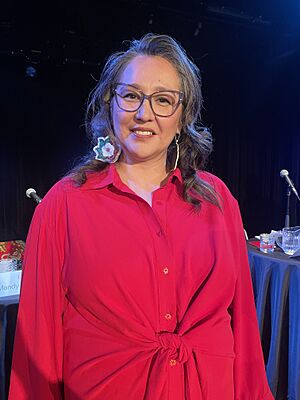Minister of Indigenous Services facts for kids
Quick facts for kids Minister of Indigenous Services |
|
|---|---|
| Indigenous Services Canada | |
| Style | The Honourable |
| Member of | |
| Reports to |
|
| Appointer | Monarch (represented by the governor general)
on the advice of the prime minister
|
| Term length | At His Majesty's pleasure |
| Inaugural holder | Jane Philpott |
| Formation | August 28, 2017 |
| Salary | CA$299,900 (2024) |
The Minister of Indigenous Services (French: ministre des services aux autochtones) is a very important person in the Canadian government. This minister is in charge of a department called Indigenous Services Canada (ISC). This department helps provide services to Indigenous peoples across Canada. These services can include things like health care, clean water, and other important support. The minister is part of the Canadian Cabinet, which is a group of top government officials who help the Prime Minister make big decisions for the country.
Mandy Gull-Masty has been the Minister of Indigenous Services since May 13, 2025. The Prime Minister chooses who will be the minister. Then, the Crown (represented by the Governor General) officially appoints them. This job was created in 2017. It took over from an older department called Indian Affairs and Northern Development. ISC now manages services like health and clean water. The Minister of Indigenous Services also works with the Minister of Crown–Indigenous Relations. Together, they help manage agreements between the Canadian government and Indigenous peoples.
Contents
Who Has Been Minister of Indigenous Services?
This section lists the people who have held the job of Minister of Indigenous Services.
| No. | Portrait | Name | Time in Office | Political Party | Government | |
|---|---|---|---|---|---|---|
| 1 |  |
Jane Philpott | August 28, 2017 | January 14, 2019 | Liberal | 29 (J. Trudeau) |
| 2 |  |
Seamus O'Regan | January 14, 2019 | November 20, 2019 | Liberal | |
| 3 |  |
Marc Miller | November 20, 2019 | October 26, 2021 | Liberal | |
| 4 |  |
Patty Hajdu | October 26, 2021 | March 14, 2025 | Liberal | |
| March 14, 2025 | May 13, 2025 | 30 (Carney) | ||||
| 5 |  |
Mandy Gull-Masty | May 13, 2025 | Incumbent | Liberal | |
Clean Water on Reserves
Since 2016, the government has spent more than $3.5 billion on water and wastewater systems. This money has helped fund over 600 projects. These projects have fixed, made bigger, or replaced old water systems. Training for people who manage water systems has also improved. More money is now given to communities to help run and maintain their water systems.
On December 2, 2020, Marc Miller, who was the minister at the time, announced even more money. Over $1.5 billion was invested to make sure First Nations communities have clean drinking water.
What are Long-term Drinking Water Advisories?
A "drinking water advisory" is a warning that the water might not be safe to drink. A "long-term" advisory means the warning has been in place for over a year. These warnings happen when a water system isn't working well. This could be because equipment is broken or there are problems with how the system is run. It means the water isn't being cleaned to the right quality.
Drinking water advisories can be put in place for several reasons. For example, if a water pipe breaks, or if the equipment that cleans the water stops working. They can also happen if the water isn't filtered or disinfected properly. Sometimes, a warning is issued if there isn't anyone trained to run the water system. Or, if there isn't anyone trained to test the water quality.
There are three main types of advisories:
- Boil water: You must boil your water before using it.
- Do not consume: You should not drink the water at all.
- Do not use: You should not use the water for anything, not even washing.
The total number of long-term drinking water advisories has gone down a lot. From November 2015 to September 2020, the number dropped by 55%. It went from 105 advisories to 58 in 35 communities. As of March 1, 2021, 55 communities were still under a long-term advisory. Most of these were in Ontario.
Some of the communities in Ontario with advisories include:
- Sandy Lake First Nation
- Muskrat Dam Lake First Nation
- Northwest Angle 33 First Nation
- Gull Bay First Nation Kiashke Zaaging Anishinaabek
- Shoal Lake 40 First Nation
- Nibinamik Neskantaga First Nation
- Anishinabe of Wauzhushk Onigum
- Mohawks of the Bay of Quinte First Nation
- Wabaseemoong
- Mishkeegogamang First Nation
- Sachigo Lake First Nation
- Washagamis Bay
- Eabametoong Oneida of the Thames First Nation
- Bearskin Lake First Nation
- Saugeen First Nation
- North Spirit Lake First Nation
- Mississaugas of Scugog Island First Nation
- Deer Lake First Nation
- Chippewas of Nawash First Nation
- Anishnaabeg of Naongashiing
- Chippewas of Georgina Island First Nation
- Wawakapewin First Nation
- Marten Falls First Nation
In British Columbia, as of January 31, 2021, 18 First Nations had advisories. These included ten "Boil Water Advisories" and eight "Do Not Consume" advisories. Some affected communities are:
- Semiahmoo First Nation
- Xeni Gwet'in First Nation (affecting 26 to 50 people)
- Wetʼsuwetʼen First Nation (affecting 51 to 100 people)
In Manitoba, communities under an advisory include:
In Saskatchewan, advisories have been issued in:
- White Bear First Nation
- Little Saskatchewan First Nation
- Ministikwan Lake Cree Nation
- Peepeekisis Cree Nation
- Peter Ballantyne Cree Nation
- Little Pine First Nation
- Star Blanket Cree Nation
See also


